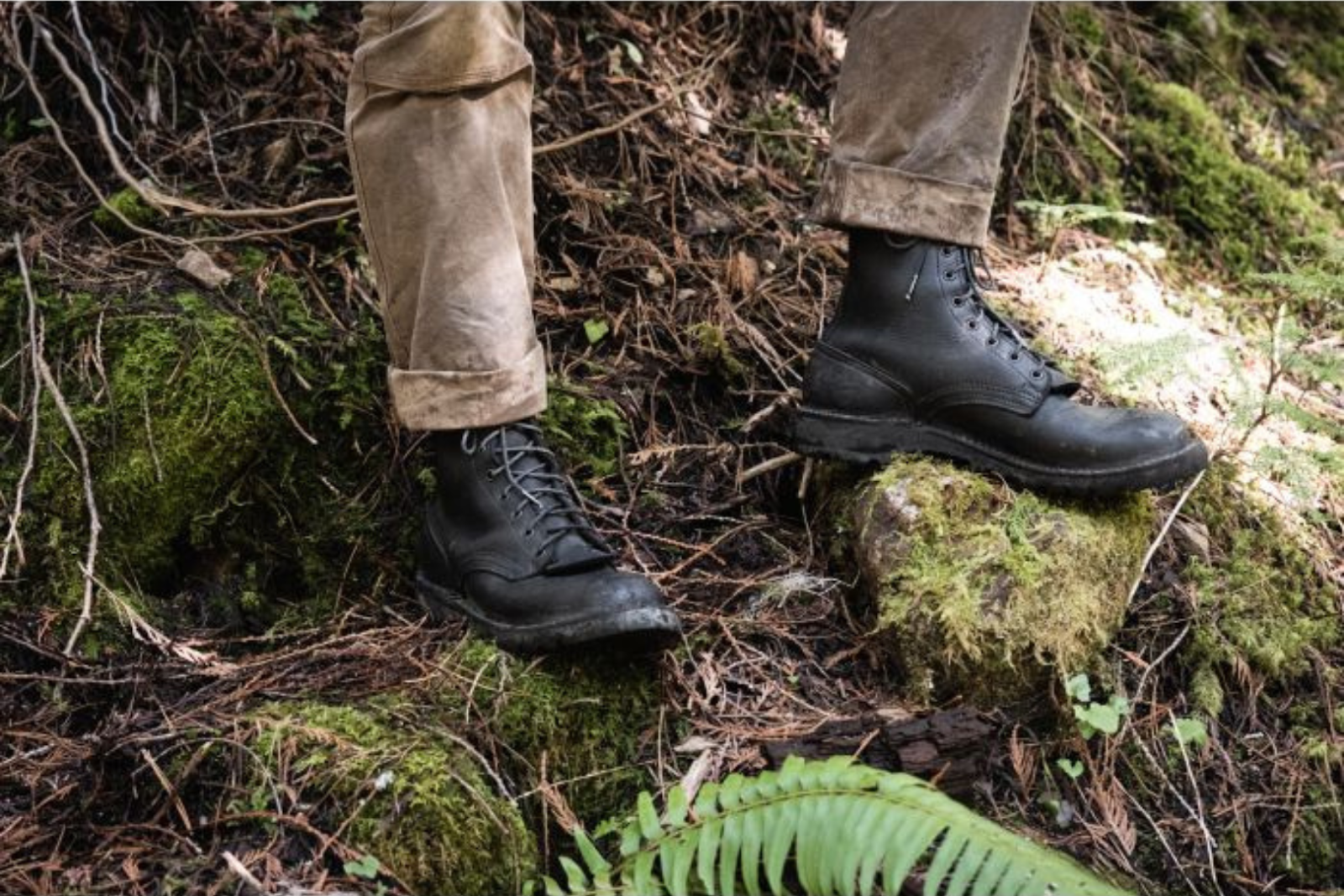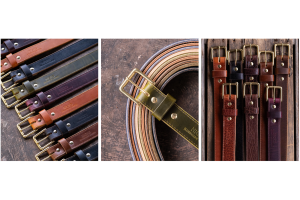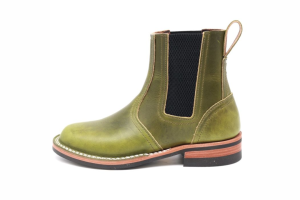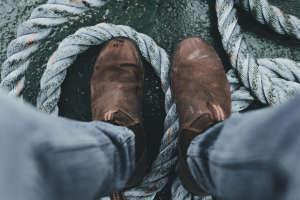Leather Hiking Boots: Exploring Durability And Style For Outdoor Adventures

Have you ever wondered what sets leather hiking boots apart from other footwear options? When it comes to embarking on outdoor escapades, the choice of footwear can make a world of difference. Enter leather hiking boots – not just shoes, but companions built to withstand the rigors of the trail while offering unmatched comfort and style.
In this article, we’ll talk about leather hiking boots, uncovering their unique features, benefits, and why they've become a must-have for both seasoned hikers and those seeking quality footwear that lasts through work and pleasure. So, fasten your laces as we journey through the rugged yet fashionable world of leather hiking boots.
Eager to know us better? Dive into our welcome page for an insight into our story or fast-track to exploring our iconic belt collection and top-selling boots!
What Are Leather Hiking Boots?
Leather hiking boots transcend mere footwear, emerging as steadfast companions during outdoor escapades. Meticulously crafted with a fusion of durable leather and ergonomic design, these boots guarantee not only sturdiness but also optimal comfort and support, whether you're conquering trails, embarking on treks, or embracing diverse adventures.
With each step, the rich heritage of leather and the precision of craftsmanship converge, elevating your journeys to a new level of durability and style.


Discover The Legend Of Nicks Handmade BootsAt Nicks Handmade Boots, we create more than just footwear; we craft enduring stories that accompany you on your adventures. Our legacy is built on the shoulders of skilled artisans who dedicate their expertise to crafting fine leather products, with our famous boots leading the way. What sets us apart:
|
Why Do Leather Hiking Boots Matter?
Leather hiking boots play a pivotal role in your outdoor experience, impacting both performance and comfort. The choice of footwear can significantly affect the quality of your adventure, making leather hiking boots an essential consideration for all outdoor enthusiasts.
- Performance Boost: Leather boots offer better grip and traction, enhancing your stability on uneven terrains.
- Foot Protection: The sturdy leather acts as a barrier against sharp rocks, thorns, and other potential hazards.
- Endurance: Leather's resilience ensures that your boots withstand the test of time, enduring various weather conditions.
- Style And Versatility: Leather hiking boots effortlessly combine style with functionality, suitable for both outdoor activities and casual wear.
- Comfort On Long Hikes: The ergonomic design of these boots ensures comfort during extended hiking sessions.
How Do Leather Hiking Boots Work?
Leather hiking boots work by providing a combination of durability, protection, and support for outdoor activities. The natural full-grain leather material is rugged and resistant to abrasion, shielding the feet from rough terrain and potential hazards. If you're looking for boots that offer this level of performance, Nick's Boots specializes in full-grain leather hiking boots designed to meet the demands of any trail. The boots' structure, often featuring ankle support and reinforced toe caps, helps prevent injuries. They offer grip and traction through their sturdy outsoles, allowing hikers to navigate various surfaces. Properly fitting leather boots provide comfort, and their breathability keeps moisture at bay, contributing to an overall enjoyable hiking experience.
What Are The Benefits Of Choosing Leather Hiking Boots?
Opting for leather hiking boots brings forth a multitude of benefits that contribute to an enjoyable and secure outdoor experience. These advantages go beyond aesthetics, offering practical features for both seasoned hikers and those new to the trail.
Durability
Leather's toughness guarantees long-lasting boots that accompany you on numerous expeditions. For those who are serious about durability, Nick's Boots offers hiking boots crafted with premium full-grain leather, ensuring that your boots are not just durable but also built to withstand the test of time.
Weather Resilience
Water-resistant treatments keep your feet dry, even when facing unexpected rain or puddles.
Terrain Adaptability
The grip provided by the outsoles lets you confidently navigate diverse landscapes.
Personalized Fit
Leather gradually molds to your foot shape, providing a custom fit over time.
Timeless Style
The classic look of leather hiking boots effortlessly complements various outfits, merging fashion with function.
What Are The Types Of Leather Used In Hiking Boots?
Leather, a versatile material, plays a crucial role in the construction of hiking boots. However, not all leather is the same. Various types of leather offer distinct characteristics, each impacting the performance, durability, and style of your hiking boots. Let's uncover the different types of leather used in crafting these exceptional footwear options.
Full-Grain Leather
Known for its natural texture and durability, full-grain leather retains the outer layer of the hide, making it resistant to abrasion and weather. It's a top choice for rugged terrains.
If you're interested in experiencing the best that full-grain leather has to offer, Nick's Boots specializes in crafting boots with this premium material, ensuring that you're equipped with footwear that's not just durable but also ages gracefully.
Top-Grain Leather
Slightly altered for a smoother appearance, top-grain leather maintains durability while offering a more uniform look.
Nubuck Leather
Created by sanding the outer layer of full-grain leather, nubuck has a soft and velvety texture, ideal for those seeking comfort and style.
Split-Grain Leather
Derived from the inner layers of the hide, split-grain leather is lighter and more affordable, often used in combination with other materials.
Suede Leather
Similar to nubuck, suede is created by sanding the inner layer of split-grain leather. It's soft and comfortable but requires special care.
What Are The Features To Look For In Leather Hiking Boots?
When seeking the perfect pair of leather hiking boots, it's essential to consider a range of features that contribute to their performance and comfort. These features ensure that your boots not only withstand the challenges of the trail but also elevate your outdoor experience.
- Waterproofing: Look for boots with waterproof membranes to keep your feet dry in wet conditions.
- Ankle Support: Opt for high-cut boots or those with padded collars for optimal ankle stability.
- Outsole Traction: Rugged outsoles with deep lugs provide an excellent grip on various terrains.
- Cushioning And Midsole Support: A well-cushioned midsole with arch support enhances comfort during long hikes.
- Lacing System: Secure lacing allows for a personalized fit and prevents discomfort.
How To Maintain And Care For Leather Hiking Boots?
Proper maintenance is key to ensuring that your leather hiking boots not only endure the elements but also maintain their functionality and aesthetic appeal. By following a few essential care tips, you can extend the lifespan of your boots and enjoy countless adventures.
- Regular Cleaning: Remove dirt and debris after each hike using a soft brush.
- Conditioning: Apply a leather conditioner to keep the leather supple and moisturized.
- Waterproofing: Reapply waterproofing treatments as needed to maintain water resistance.
- Drying: Allow boots to air dry at room temperature after use, avoiding direct heat sources.
- Storage: Store boots in a cool, dry place away from direct sunlight to prevent cracking.
For a comprehensive cleaning solution, check out Nick's Ultimate Boot Care Kit. It's equipped with everything you need to ensure your boots remain in pristine condition, no matter how often they need a touch-up.
What Are The Proper Comfort And Fit Considerations?
No matter how sturdy or stylish your leather hiking boots are, they're only as good as their fit. Comfort and fit are paramount for a pleasurable hiking experience, as ill-fitting boots can lead to discomfort and blisters. Here's what you should keep in mind.
Sizing Accuracy
Measure your feet accurately and refer to manufacturer size charts.
For a truly personalized fit, Nick's Custom Boots offer the opportunity to tailor every aspect of your boots, from the size and width to the type of leather and sole, ensuring you get the most comfortable and well-fitting boots possible.
Toe Room
Ensure adequate toe room to prevent cramped feet on descents.
Heel Lock
Your heel should stay snug to minimize friction and blisters.
Arch Support
The boots should provide arch support that matches your foot's shape.
Trial And Break-In
Wear your boots before long hikes to break them in and identify any discomfort.
What Are The Downsides Of Leather Hiking Boots?
While leather hiking boots offer numerous advantages, it's essential to consider potential downsides:
- Break-In Period: Leather boots might require a break-in period to achieve optimal comfort.
- Weight: These boots can be heavier compared to some synthetic alternatives.
What Are The Alternatives To Leather Hiking Boots?
While leather hiking boots offer exceptional qualities, it's essential to be aware of alternatives that might suit your preferences and needs. Different materials and styles cater to diverse hiking styles and personal choices.
- Synthetic Hiking Boots: These boots often weigh less and dry faster, making them suitable for humid environments.
- Trail Running Shoes: Ideal for light hiking, these shoes offer flexibility and are designed for speed on less demanding terrains.
- Fabric And Leather Hybrids: Some boots combine leather with breathable fabric to balance durability and ventilation.
- Mountaineering Boots: Designed for more challenging terrain, these provide maximum support but can be heavier.
- Minimalist Footwear: Catering to those who prefer a barefoot-like experience, these shoes are lightweight and offer natural movement.
History Of Leather Hiking Boots
The history of leather hiking boots dates back to ancient civilizations, where people relied on leather footwear for protection during outdoor activities and journeys. However, the modern concept of leather hiking boots emerged in the early 20th century, driven by the need for sturdy and comfortable footwear for mountaineering and trekking. Over time, advancements in tanning techniques and boot construction led to the development of more specialized and durable leather hiking boots, becoming a staple for outdoor enthusiasts and adventurers worldwide.
Current Environment Of Leather Hiking Boots
Leather hiking boots continue to be popular choices among outdoor enthusiasts and hikers. They offer a blend of durability, classic aesthetics, and reliable performance on various terrains. While advancements in synthetic materials have introduced lighter options, leather hiking boots still hold a significant presence, particularly among those who prioritize long-lasting footwear and appreciate the traditional charm of leather. Additionally, eco-conscious consumers are increasingly seeking sustainably sourced and ethically produced leather options, driving efforts to align leather boot production with environmental and ethical considerations.
Frequently Asked Questions
Can leather hiking boots cause blisters during the break-in period?
While some discomfort might occur during the break-in period, properly fitted boots and wearing quality hiking socks can minimize the risk of blisters.
What is the difference between leather and synthetic hiking boots?
Leather hiking boots are made from natural animal hide, providing durability and a classic look, while synthetic hiking boots are crafted from man-made materials like nylon or polyester, often prioritizing lightweight design and immediate water resistance.
Are there vegan alternatives to leather hiking boots?
Yes, synthetic and vegan hiking boots are available for those who prefer non-animal-derived materials.
Can I wear leather hiking boots for everyday use?
Absolutely, the durability and style of leather hiking boots make them suitable for both outdoor adventures and daily wear.
How should leather hiking boots fit?
A snug fit is essential without feeling too tight. Your toes shouldn't touch the front, and your heel should remain in place without excessive movement.
Are leather hiking boots a good investment?
Yes, investing in high-quality leather hiking boots pays off in the long run due to their longevity and performance.
Can leather hiking boots be resoled?
Yes, many leather hiking boots can be resoled, which can extend their lifespan. Check with the manufacturer or a professional cobbler to determine if your boots are suitable for resoling.
Can I use leather conditioner on old and dry leather hiking boots?
Yes, using a leather conditioner on old and dry leather hiking boots can help restore their moisture and flexibility. It's a good practice to condition them periodically to prolong their life.
Are leather hiking boots suitable for people with wide feet?
Some leather hiking boot models offer wider sizing options to accommodate individuals with wider feet. Look for boots labeled "wide" or "wide width."
How can you tell if leather boots are of good quality?
To determine good-quality leather boots, check for full-grain leather, strong stitching, solid construction, comfortable interior, durable hardware, effective lacing, and a reputable brand.




